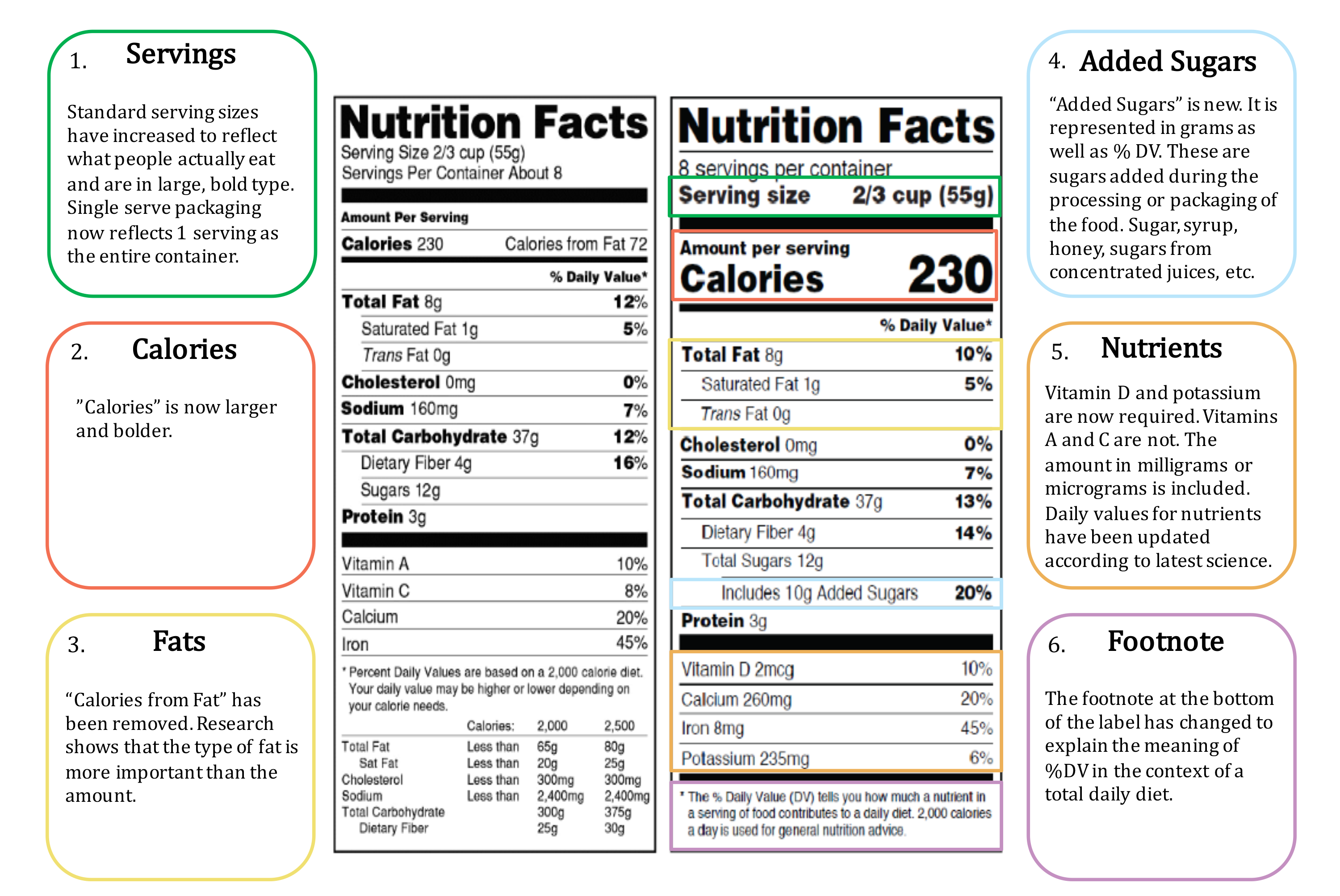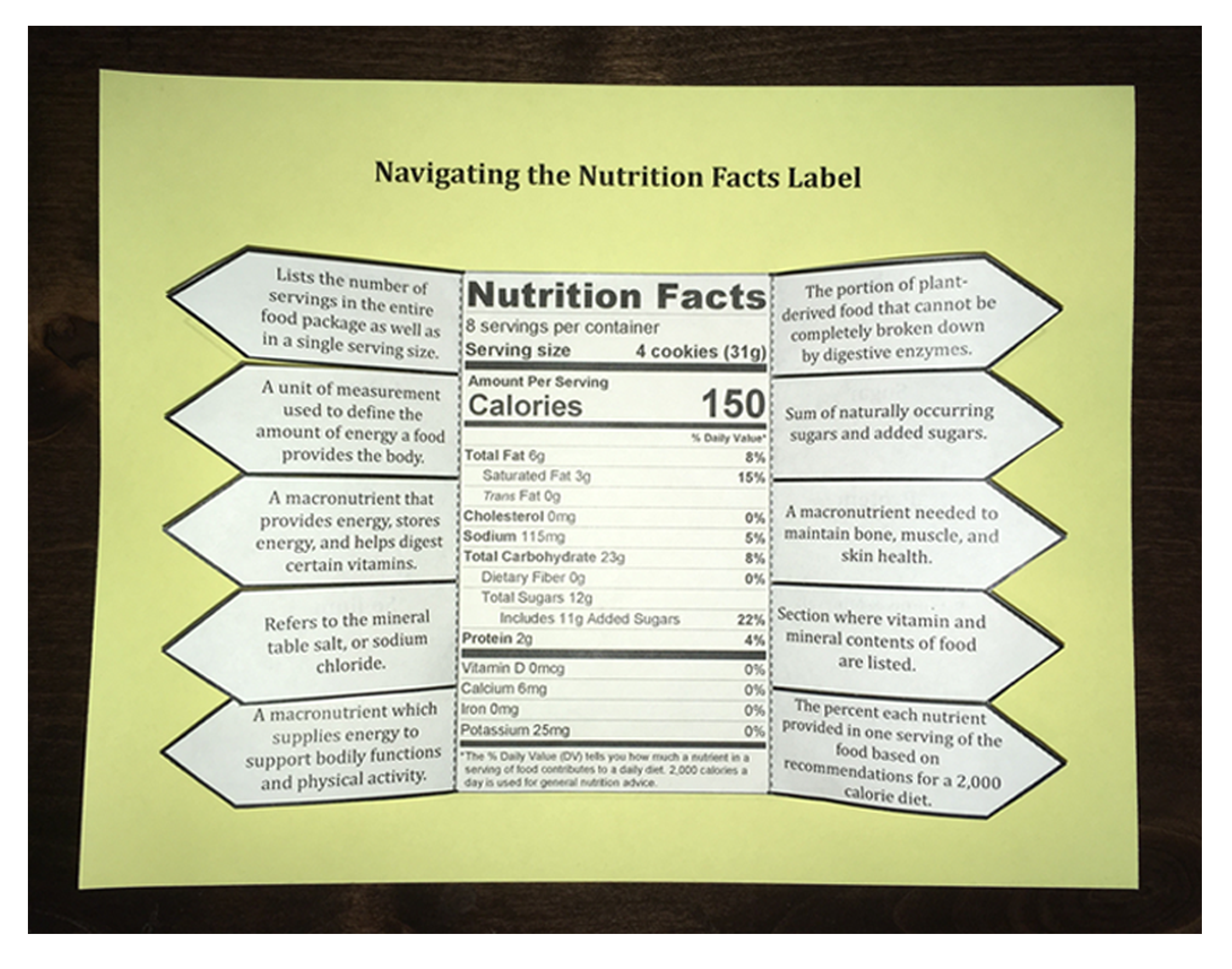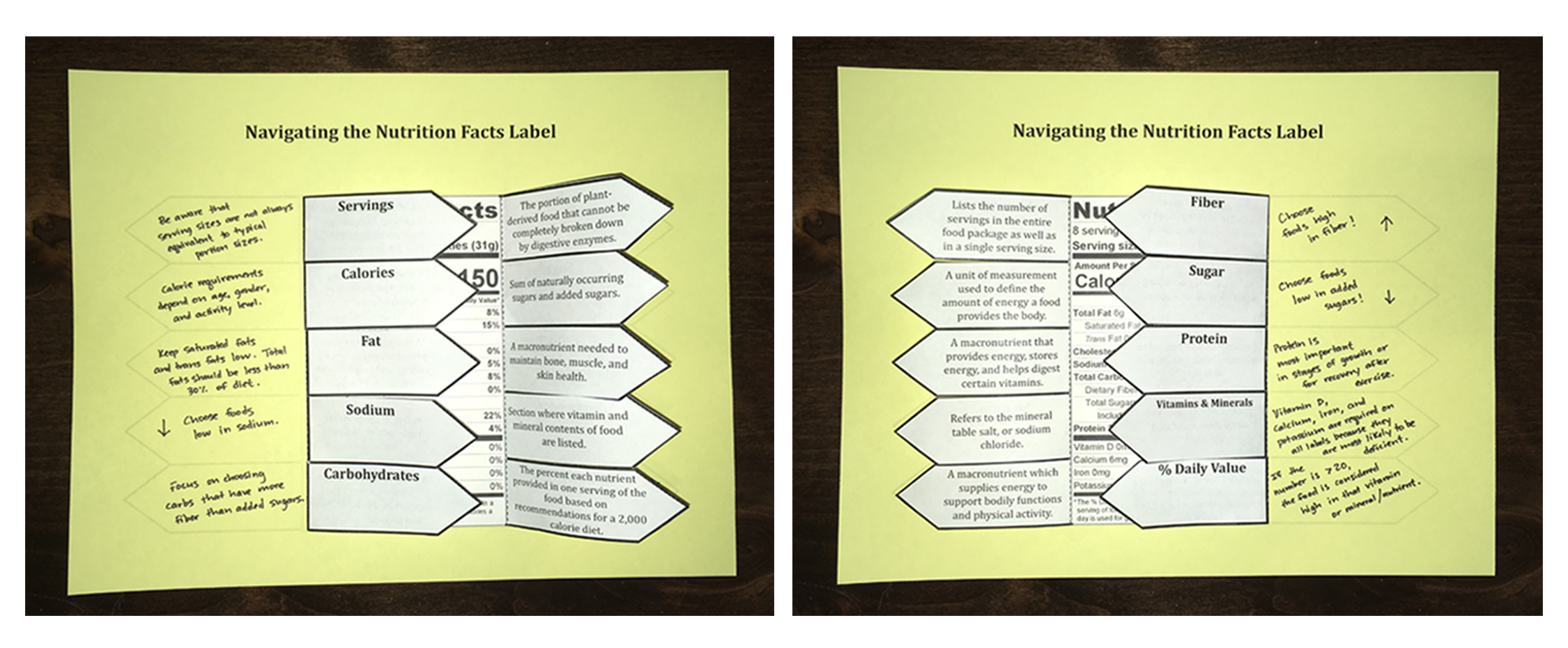Reading a Nutrition Food Label School Lesson
Lesson Plan
What's New on the Nutrition Facts Label?
Purpose
Students volition be introduced to the redesigned Nutrition Facts label beingness implemented from 2016-2020, navigate and decipher the Diet Facts label, utilise food labels to decide nutritive value of foods, and ascertain terminology found on the characterization such every bit calories, nutrients, and servings.Grades nine-12
Estimated Time
60-90 minutes
Vocabulary Words
Food and Drug Administration (FDA): a federal agency in the United States responsible for protecting the public health by ensuring the safety, efficacy, and security of human and veterinarian drugs, biological products, medical devices, and the safety of our nation's food supply
Nutrition Facts: a label required past police on food packages indicating the nutritional limerick of the nutrient
Did You Know? (Ag Facts)
- Nutrient manufacturers determine the nutrient contents of their ain products to signal on the Nutrition Facts characterization. The FDA does non initially check for accuracy, but they collect samples to monitor accurateness of the information provided. 1
- In 1862, President Abraham Lincoln signed into law the Us Department of Agriculture. Lincoln called the USDA "The People's Section" because it touches the lives of every American, every day. The USDA still fulfills this mission overseeing the product of our food.2
- The origin of the FDA traces back to the 1906 Pure Food and Drugs Act.3
Background Agricultural Connections
In the 1960s, most Americans were preparing their food at dwelling house from scratch. Within a few years, the demand and cultural preferences began shifting toward prepared and prepackaged foods. After outbreaks of food borne illness and growing allergy concerns, consumers wanted more data about the packaged food they were buying. The Diet Facts label was the solution. The Nutrition Facts label has been printed on retail foods since the 1960s. Nutrition labels are standardized and regulated by the Food and Drug Administration (FDA) for consistency and accuracy.
The last major modify to the Nutrition Facts label was initiated in 2016. Food companies have until January 2020 to implement the food characterization changes, so both label formats may be institute until then.
Changes were developed based on new scientific research and an attempt to aid consumers connect their dietary choices with chronic disease. The new nutrient label is designed to be easier for consumers to read and understand, assuasive them to make more informed choices nigh the food they swallow. Changes include the following:
- The blazon size has been increased and bolded for "calories," "servings per container," and "serving size."
- The Daily Values (% DV) footnote has been updated to define what Daily Value ways.
- The amount of sugars in the form of syrup, sugar, honey, or sugars from concentrated fruit or vegetable juice is included in a new section of the label called "Added Sugars." This new add-on to the label was added because inquiry has shown it is difficult to stay under your calorie intake if you lot are consuming more 10% of your nutrition in added sugar.
- Vitamin D, potassium, calcium, and iron are now required nutrients to be listed on the diet characterization. They are listed both in pct Daily Value (DV) and measured by weight (mg or mcg).
- "Calories from Fat" has been removed considering it is more than important to know the type of fatty you are consuming.
- Serving sizes will exist based on the amount people are actually eating. Typical serving sizes accept increased over the years. For instance, a serving of ice foam used to be 1/2 cup, only it volition now exist two/3 loving cup.
Nutrition Facts labels are important tools to help consumers be aware of the contents of their foods in order to meet and not exceed their diet requirements. Food labels comprise the post-obit information:
- Servings Per Container: Shows the total number of servings establish in the entire package.
- Serving Size: This quantity is based on the amount customarily eaten at one fourth dimension, though typical serving sizes oftentimes exceed recommended serving sizes.
- Calories: A unit of measurement used to ascertain the amount of energy a nutrient provides the body.
- Fat: A macronutrient that provides free energy, stores free energy, and helps digest fat-soluble vitamins. There are four types of fat; polyunsaturated fat, monounsaturated fat, saturated fatty, and trans fat.
- Sodium: Refers to the mineral table common salt, or sodium chloride. Sodium helps in the function of nerves, muscles, and fluid balance in the body.
- Carbohydrate: A macronutrient which supplies energy to support bodily functions and physical action. Carbohydrates include sugars, starches, celluloses, and gums.
- Fiber: The portion of plant-derived food that cannot exist completely cleaved down by digestive enzymes. Fiber improves digestive health and lowers take chances of many chronic diseases.
- Sugar: The sum of naturally occurring sugars and added sugars in a food. Naturally occurring sugars would include fructose in fruit or lactose in dairy products. Added sugars are those added in the processing of food in the class of table sugar, honey, syrups, etc.
- Protein: A macronutrient needed to maintain bone, musculus, and skin health.
- Vitamins and Minerals: This section declares the amount of vitamins or minerals found in each serving of food. Vitamin D, calcium, iron, and potassium are required on the label because they have been plant to be most at take chances of being deficient in the United States.
- % Daily Value: The percent of each nutrient provided in one serving of the food based on recommendations for a two,000 calorie diet.
Interest Approach - Appointment
- Before class, get together 8-10 different nutrient products, and display them on a table or countertop where your class tin can run into them.
- At the beginning of class, challenge the students to place the food in guild from the greatest to the least amount of sugar per serving. You may cull to invite one or two students to categorize the food in front of the class or seek input from your entire course to accomplish the chore together.
- Requite pupil(southward) 1-2 minutes to complete the challenge. Later student(s) finish, ask how they came to their conclusion. If the students did not apply the Nutrition Facts labels on the food packages, ask the class, "Is at that place a way to obtain this information from the food we eat? (Yes, the Nutrition Facts label.)
- Use the Nutrition Facts labels to cheque the accuracy of the food ranking. Bear witness students where the nutrition labels can be found on the food packages. Inquire students if whatsoever of the food surprised them by having more or less sugar than they imagined.
- Explicate that about every packaged food sold in a grocery store is required to have a food characterization. Inquire the students why they think it is important to have labels on the food nosotros eat. (To know the amount of saccharide/fat and other nutrients, for consumers to address specific health concerns impacted by their diet, or to avoid nutrient they are allergic to.)

Procedures
Activity 1: What's New on the Nutrition Facts Label?
- Explicate to the class that since the 1960s, packaged foods have independent a Nutrition Facts label. Since then, labels have been modified and improved to add clarity and address societal patterns in food consumption. In 2016, the most recent change occurred. Food manufacturers have until 2020 to convert their labels to the new format. As a outcome, you volition see both new and one-time labels on your foods until then.
- Manus out the What's New on the Nutrition Facts Label handout. Explain to the students that the nutrition label on the left is the old food label, and the one on the right is the new food label. Instruct students to circumvolve or highlight the differences they find between the two food labels.
- Teacher tip: Students might notice a few of the numbers are different. For example Full fat per centum is x% on the one-time label and 12% on the new. Those are non the differences they are trying to find.
- Later students have 2-iii minutes to circle and highlight the differences, invite students to share their answers. Project the attached What'due south New on the Nutrition Facts Label Key for students to see. Outline and explain each alter to the label. Explain that the changes have occurred as a consequence of scientific research and a response to trends occurring in our society. The new formatting and requirements for the Nutrition Facts label are intended to make the label easier to read and assistance consumers brand more educated decisions on their dietary intake.
- Using the foods found in your classroom (foods from the Interest Arroyo also as drinks or snacks your students may have with them), take students look at the Nutrition Facts labels and determine which are the new labels and which still have the old formatting. Discuss the benefits (or drawbacks) of the new label.

Activeness 2: Navigating the Nutrition Facts Label
- Stimulate thinking virtually the Nutrition Facts labels by asking, "Besides raw, unpackaged produce and some fresh fish and meat cuts, what foods can you find at the grocery shop that are Non required to take a Diet Facts label?" (Foods that incorporate insignificant amounts [zero] of all required nutrients. Examples include tea, coffee, food coloring, and spices.) If students do not come up with the correct respond, offer an incentive to the person who comes to the next class with the answer.
- Give each student one re-create of the Navigating the Nutrition Facts Label handout and i copy of the Foldable Notes cutout page (printed front to back).
- Instruct students to cut out the Foldable Notes folio and mucilage or tape information technology to their handout. Show them an example and remind them to cut forth the solid lines and fold on the dotted lines.

- Ask students why it is important to exist able to read and understand a Diet Facts label?(To know the amount of nutrients we are putting into our bodies, to avert under or over nourishment, and to help u.s.a. exist educated well-nigh the foods nosotros are eating.)
- Projection the Navigating the Nutrition Facts Label PowerPoint and use information technology as a guide for a discussion with your students. Innovate and explain each portion of the Nutrition Facts label. Instruct students to add some notes to their handout under each tab (see example below).

- Summarizethat the Nutrition Facts label helps us consume and live healthier as we are more informed about the nutrient content of our food. Lookout, Nutrient Label Smarts.
Activity iii: Ranking Food Labels
- Divide the course into groups of 3-4 students. Requite each group 1 set of Nutrition Facts Label Cards. (They should have x cards per group.)
- Explain to the students that they will be evaluating each nutrition characterization and ranking the foods according to different parameters. Direct the activity with the unabridged class, or provide a job list for individual groups to work independently.
- Utilize equally many categorizing activities every bit time allows. Examples include:
- Rank from highest to lowest
- Number of calories
- Full fat
- Sodium
- Dietary Fiber
- Full sugars
- Added sugars
- Protein
- Vitamin D
- Calcium
- Iron
- Potassium
- Compare or find correlations
- Is in that location any correlation between total carbohydrates and total sugars? (Yes, sugars are a specific type of carbohydrate. Foods high in sugar are frequently also high in carbohydrates.)
- Which food provides a significant source (xx% or greater) of i of the 4 vitamins/minerals (Vitamin D, potassium, calcium, and fe)? (Cheese pizza-calcium)
- What is unique or different virtually the Oats and Honey Clusters label? (Explain to students the use of the dual column label. Certain food products that tin can exist eaten in one sitting have a dual cavalcade label listing the calories and nutrients per serving too equally per package.)
- Rank from highest to lowest
- Ask follow up questions such as, "Did anything surprise you about these foods?" or "What questions do you have?"
Concept Elaboration and Evaluation
After conducting these activities, review and summarize the follow key concepts:
- Regime organizations such as the FDA oversee the labeling of foods in the United States. They set standards for food processing companies to follow to communicate nutrition facts to consumers.
- Accurately reading a Nutrition Facts characterization and using the information to follow dietary recommendations can aid atomic number 82 to a healthier diet and lifestyle.
- A variety of foods can contribute to a healthy diet.
- All foods are required to take a Nutrition Facts label with the exception of raw produce, some fresh meat cuts, and foods with goose egg nutritional content such as coffee, tea, or spices.
Enriching Activities
-
Students accept only learned virtually the Diet Facts characterization institute on the side or back of food packages. Many food packages also have nutritional health claims that are ofttimes found on the front of nutrient packages. Read Health Claims on Food Labels to expand noesis of the information found on the front of food packages.
-
Take students construct their own food label for their favorite recipe.
-
Assign students a homework assignment to find ii Nutrition Facts labels; one in the new format and one in the one-time format.
-
Watch the video clip, What is a calorie?
Organization Affiliation
National Eye for Agricultural Literacy
| | Nosotros welcome your feedback. Please take a minute to share your thoughts on this lesson. |
Source: https://agclassroom.org/matrix/lesson/666/
Belum ada Komentar untuk "Reading a Nutrition Food Label School Lesson"
Posting Komentar